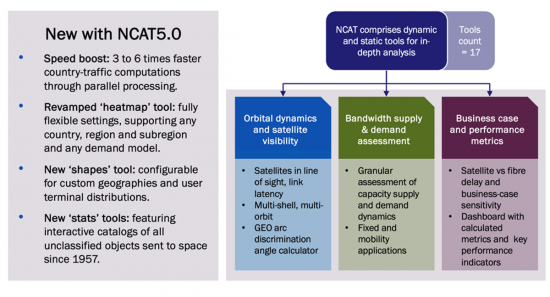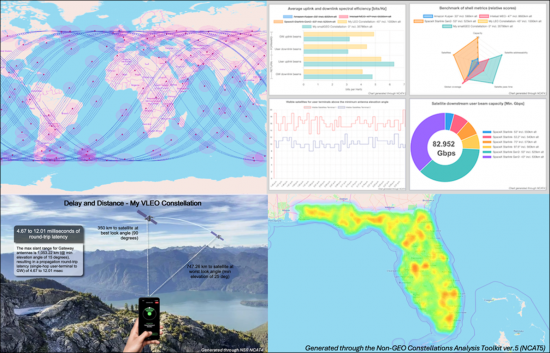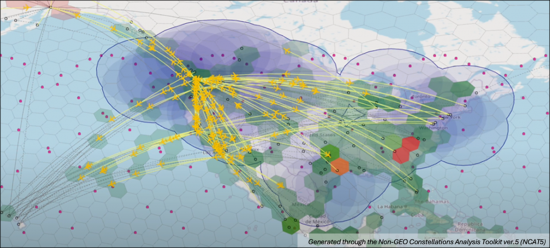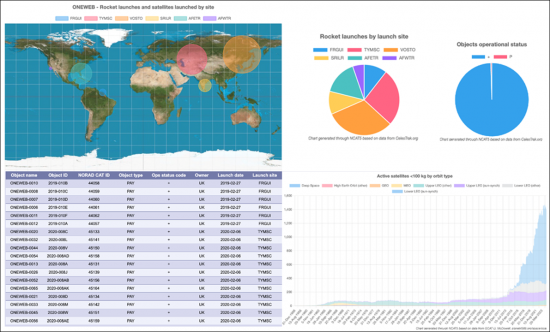
|
연간정보 서비스
상품코드
1568193
비GEO 성상도 분석 툴킷 5.0Non-GEO Constellations Analysis Toolkit 5.0 |
||||||
비 GEO 성상도 분석 툴킷(NCAT)은 데이터 세트 및 분석, 양방향 시각화를 결합하여 LEO(저 궤도) 및 MEO(중간 궤도) 위성 성상도의 실제 성능을 평가합니다.

전략가 및 비즈니스 및 기술 전문가는 NCAT 플랫폼을 활용하여 NGSO 위성 별자리의 성능과 국가 및 지역에 미치는 영향을 분석할 수 있습니다.
새로 출시된 NCAT v5.0(NCAT5)은 온라인 WebApp로 제공되며 대역폭 수급 동향, 시장 대응 가능성, 비즈니스 사례 감도를 세밀하게 평가하는 도구가 강화되었습니다. 또한 새로운 지표를 도입하여 지상파 네트워크와 별자리경쟁 구도를 비교합니다.
툴킷 적용 범위
NCAT5는 60,000행 이상의 오리지널 코드와 200만 라인의 쿼리 가능한 데이터베이스를 활용하여 별자리의 성능 지표와 능력에 대한 편견 없는 평가를 수행합니다. 수백만 개의 계산은 필터, 시각화 컨트롤 및 사용자 입력을 사용하는 사용하기 쉽고 구성 가능한 도구로 동적으로 계산됩니다.

이 보고서의 주요 특징 :
- 엄격하게 코딩된 알고리즘: 사실에 기반한 분석 및 시각화를 추진.
- 종합적인 데이터베이스 : 업데이트주기가 향상되어 사용자는 새로운 시뮬레이션을 쉽게 수행 할 수 있습니다.
- 매일 업데이트 : 궤도 위성 수(Starlink, SES mPOWER, OneWeb 등)와 궤도 관측치가 매일 자동으로 업데이트됩니다.
- 매주 업데이트: 새로운 통계 도구는 매주 자동으로 업데이트되는 광범위한 위성 카탈로그를 활용합니다.
- 분기 업데이트: 핵심 소프트웨어 및 데이터베이스 향상은 분기별로 수행됩니다.
- 포인트 앤 클릭 양방향: 대화형 맵 및 제어 기능(레이어, 필터, 버튼, 설정)을 통해 사용자는 확대/축소, 클릭으로 사용자 단말기 위치 설정, 동적 계산 및 시각화 컨트롤을 할 수 있습니다.
- 다중 궤도, 다중 대역 분석 : 시뮬레이션은 하나 이상의 시스템의 쉘 조합에 대해 구성 가능하며 수천 개의 위성에 대해 동시에 계산을 수행합니다.
- 동적 애니메이션으로 시각화: 위성 위치, 실적, 가시 위성, 안테나 룩앵글, 링크 지연 변화, 수급 히트맵 등 전파 상황을 실시간으로 시각화할 수 있습니다.
- 시간·공간 제어: NCAT5에서는 세계 전체, 지역별·국소적으로 실시간 분석과 고속 타임랩스 분석이 가능합니다.
- 시뮬레이션은 최대 300배까지 빨라질 수 있으므로 툴킷 사용자는 약 5분 내에 하루에 별자리 기능을 수행할 수 있습니다.
- 육각형 지상 그리드: NCAT5는 국가 수준의 정확도를 도시 크기까지 설정할 수 있는 역동적인 육각형 그리드를 사용합니다(셀 반경은 최대 9km).
- 새로운 'shapes' 도구를 사용하면 NCAT 데이터베이스에 사전 설정된 258개국 및 지역을 제외한 모든 지역을 정의할 수 있습니다.
- 향상된 처리량 계산: 게이트웨이와 사용자 단말기의 룩 앵글 조합에 대해 모든 사용자와 게이트웨이 빔에서 링크 예산 처리량 분석을 동시에 계산합니다.
- 완전 유연한 수요 모델: NCAT5는 사용자가 다양한 사전 설정된 기준 중에서 선택할 수 있으며 고객 수요의 요인을 정의할 수 있습니다(사용자 단말기 분포, 대역폭 수요 계산 기능 등).
- 수요 주도형 공급: 선택 가능한 공급 공정성 기준을 통해 NCAT는 변화하는 수요 조건에 맞게 가변식 빔 용량 재구성을 시뮬레이션합니다.
- 이동성 도구 : NCAT 서버는 민간 비행기의 출처에 연결되어 IFC(기내 연결)의 수급 동향(수만 건의 항공로, 항공사 및 공항)을 평가하는 데 사용됩니다.
- 통계 데이터: NCAT5에서는 1957년 이후 우주에 발사된 6만 1,000점 이상의 미분류 천체의 카탈로그와 연동하는 2점의 새로운 통계 툴을 도입했습니다.
- 다운로드 가능한 차트 및 데이터: 모든 도표, 지도, 인포그래픽은 PDF/PNG 형식으로 다운로드 가능합니다. 출력 데이터는 표 형식의 CSV 형식으로 다운로드할 수 있으며, 플랫폼 이외에도 추가로 처리할 수 있습니다.
- 표, 차트 데이터, 벤치마크 지표, 타임스탬프가 있는 샘플, 수급 데이터가 있는 지상 그리드, 평가 요약, 비행 경로, 룩앵글 통계, 빔 이용률 등
활용 영역 |
NCAT는 위성 통신(satcom)에 초점을 맞추고 있지만, 지구관측(EO)과 전 지구 항법 위성 시스템(GNSS)을 평가하는 기능도 포함되어 있습니다. |
도구 |
사용하기 쉽고 구성 가능한 17유형 툴로 다음과 같은 다각적인 분석 및 벤치마크가 가능합니다.
|
별자리 쉘 |
90건 이상의 운용중, 계획중, 신청중의 시스템이 사전 설정이 끝났습니다(유저 스스로 편집·확장할 수 있습니다) |
게이트웨이 |
370개 이상의 조사된 위치(사용자 직접 편집 및 확장 가능) |
조사 대상 지역 |
258개 국가, 지역, 지역 및 하위 지역이 사전 설정되었습니다(사용자 직접 편집 및 확장 가능). |

본 보고서에서 답변한 질문
- 현재 향후 NGSO 아키텍처는 통신 범위, 용량, 빔 및 위성을 포함한 여러 계층에서 어떻게 벤치마크를 구현하는가?
- 게이트웨이/사용자 빔, 위성 및 하위 별자리당 전방/후방 링크 용량(주파수, 대역폭, IP 처리량)은 얼마입니까?
- 사용 가능한 자본 비용(1Mbps당)은 어떻게 추측할 수 있는가?
- 위성의 제조·발사 비용의 각 요소에 대해, 비즈니스 케이스는 얼마나 반응하는 것인가?
- 접속 서비스가 아직 정비되어 있지 않은 지역에서는 어떤 조건하에서 위성 통신별자리는 광섬유보다 경쟁력을 가지게 되는 것인가?
- 버백홀의 비즈니스 케이스는 설비 투자와 운영 비용에 얼마나 민감한가?
- 조정 가능한 이동성/고정 광대역 서비스 계획에 따라 대역폭 수급을 실제로 평가하려면 어떻게 해야 합니까? 혼잡 지역은 어디서, 시간이 지남에 따라 어떻게 변화합니까?
- 모든 위도에서 그리고 쉘마다/쉘의 조합 마다, 「시야에 들어가거나」 전망선상(LoS)에 있는 위성의 최대수, 평균수, 최소수는 어느 것인가?
- 광섬유 지연은 LEO 시스템이나 토폴로지에 비해 어떻게 되는가? POP나 OISL(광위성간 링크)의 사용, 링크 릴레이 등의 영향은 있는가?
- GEO(GSO) 시스템과의 간섭을 피하기 위해 NGSO 시스템의 규제 제외 각도는 얼마나 되는가?

이 툴박스 이용자:
- 기존/.신규 위성 오퍼레이터(GSO와 NGSO, FSS와 MSS/D2D)
- 우주선 제조업체 및 컴포넌트 벤더
- 지상·무선 네트워크 오퍼레이터: 통신 기업, MNO, 통신탑 사업자, 케이블 사업자, IP 트랜짓, WLL, 클라우드 서비스 제공업체 포함)
- 지상 시스템 벤더(단말, MSA/ESA 안테나, 허브/모뎀, SD-WAN, 지상 네트워크 가상화)
- 텔레포트 오퍼레이터, 위성 서비스 제공업체, NGSO 매니지드 서비스의 인티그레이터 유통업체
- 정부 및 방위·상업 최종 사용자를 포함한 NGSO 용량의 주요 사용자(항공사, 크루즈 회사, 에너지 기업 등)
- 업계 단체, 연구소, 연구 기관
- 콘스텔레이션용 가상화 클라우드 소프트웨어 솔루션을 개발하고 있는 IT 기업
- 규제 당국 및 주파수 연구 기관
- 금융기관, 투자운용, 보험
포함된 위성 시스템(예)
Amazon Project Kuiper, AST SpaceMobile, Boeing, E-Space, G60 SailSpace, GW-2, GW-A59, Hughes, Inmarsat Orchestra, Intelsat MEO, Iridium, Kepler, Lynk Global, Mangata Networks, Omnispace, OneWeb, RivadaSES & O3b, SpaceX Starlink, Telesat Lighspeed, ViaSat.
NCAT는 온라인으로 구성 가능한 툴 세트로서 무제한의 사용성을 가지며, 주요 NGSO 시스템의 데이터 세트(부여된 시스템, 운영중인 시스템, 제안된 시스템을 포함)가 미리 입력된 상태에서 제공됩니다.
시장 코멘트
"우수한 도구 세트! 유연 하고 시각적이며 사용 하기 쉽고 상세한 분석이 가능합니다."
JHS 24.10.30The Non-GEO Constellations Analysis Toolkit (NCAT) fuses datasets, analytics and interactive visualisations into factual performance assessments of LEO and MEO satellite constellations.

Strategists, business and technical professionals alike leverage the NCAT platform to analyse the capabilities of NGSO constellations and their impact in any country or region.
Delivered as an online WebApp, the newly released NCAT v5.0 (NCAT5) includes enhanced tools for granular assessments of bandwidth supply and demand dynamics, market addressability and business case sensitivity. It also introduces new metrics and compares the competitive standing of constellations with that of terrestrial networks.
Toolkit coverage
NCAT5 leverages over 60 thousand lines of original code and 2 million query-able database rows to drive unbiased assessments of constellations' performance metrics and capabilities. Millions of calculations are computed dynamically through tools that are easy to use and configurable though filters, visualisation controls and user inputs.

Features include:
- Rigorously coded algorithms: driving factual analytics and visualisations.
- Comprehensive database: with enhanced update cycles for users to run fresh simulations effortlessly.
- Daily updates: the number of in-orbit satellites (Starlink, SES mPOWER, OneWeb, etc.) and their orbital observations are updated daily and automatically.
- Weekly updates: the new statistics tools leverage extensive satellite catalogues updated weekly and automatically.
- Quarterly updates: enhancements to the core software and database are deployed quarterly.
- Point-and-click interactivity: through interactive maps and controls (layers, filters, buttons and settings) users zoom in/out, click to set user-terminal locations and control dynamic calculations and visualisations.
- Multi-orbit, multi-band analysis: simulations are configurable for combinations of shells from one or multiple systems, driving calculations concurrently for thousands of satellites.
- Dynamic, animated visualisations: users visualise propagating conditions in real time including satellites position, footprint, visible satellites, antenna look angles, link latency variations, supply and demand heatmaps, etc.
- Space-time controls: NCAT5 allows real-time and accelerated time-lapse analysis globally, regionally or locally.
- Simulations can be accelerated up to 300 times, allowing toolkit users to run an entire day of constellation performance in around 5 minutes.
- Hexagonal ground grid: NCAT5 uses a dynamic hex-grid with country-level precision configurable down to city-size resolution (~9 km cell radius).
- The new 'shapes' tool allows users to define any geography beyond the 258 countries and regions preset in the NCAT database.
- Boosted IP throughput computations:computes link-budget throughput analysis concurrently on all user and gateway beams for combinations of gateway and user-terminal look angles.
- Fully flexible demand models: NCAT5 allows users to select from different pre-set criteria or define custom demand factors, including the distribution of user terminals and functions driving the bandwidth demand calculations.
- Demand-driven supply: via selectable supply fairness criteria, NCAT simulates reconfigurations of steerable beam capacity to meet changing demand conditions.
- Mobility tool: the NCAT server is linked to sources of commercial flights information for the assessment of in-flight connectivity (IFC) supply/demand dynamics (tens of thousands of flight routes, airlines and airports).
- Statistics: NCAT5 introduced two new statistics tools that interact with catalogues of over 61 thousand unclassified objects launched to space since 1957.
- Downloadable charts and data: all charts, maps and infographics are downloadable in PDF/PNG format. The output data is downloadable in tabular CSV format to allow further processing outside the platform.
- Tables, charts data, benchmark metrics, time-stamped samples, terrestrial grids with supply and demand data, assessment summaries, flight routes, look angle stats, beam utilisation, etc.
Applications |
NCAT is focused on satellite communications (satcom) but includes features to assess earth observation (EO) and global navigation satellite systems (GNSS). |
Tools |
17 easy-to-use, configurable tools to analyse and benchmark systems from multiple angles, including:
|
Constellation shells |
90+ operational and planned or filed systems preset (user editable and expandable) |
Gateways |
370+ surveyed locations (user editable and expandable) |
Geographical regions |
258 countries, territories, regions and subregions preset (user editable and expandable) |

Questions answered:
- How does current and future NGSO architecture benchmark at multiple layers including coverage, capacity, beams and satellites?
- What is the forward and return link capacity (spectrum, bandwidth and IP throughput) per gateway/user beam, satellite and sub-constellation?
- How can the capital cost per usable Mbps be inferred?
- What is the business-case sensitivity to satellite manufacture and launch cost elements?
- Under what conditions can satcom constellations become more competitive than fiber optics to target underserved communities?
- How sensitive is the backhaul business case to capex and opex?
- How to assess bandwidth supply and demand factually, based on configurable mobility and fixed broadband service plans? Where are the congestion areas and how do they shift over time?
- What is the maximum, average and minimum number of satellites 'in view' or line of sight (LoS) across all latitudes, per shell and combination of shells?
- How does fibre latency benchmark against LEO systems and topologies, depending on POPs, use of optical inter-satellite links (OISL) and link relays?
- What are the regulatory exclusion angles for NGSO systems to avoid interfering with GEO (GSO) systems?

Who should use this toolbox:
- Established and emerging satellite operators (GSO & NGSO, FSS & MSS /D2D)
- Spacecraft manufacturers and component vendors
- Terrestrial and wireless network operators including telcos, MNOs, towercos, cable operators, IP transit, WLL and cloud service providers
- Ground system vendors (terminals, MSA/ESA antennas, hub/modems, SD-WAN, ground-network virtualisation)
- Teleport operators, satellite service providers, integrators and distributors of NGSO managed services
- Major users of NGSO capacity including government, defence and commercial end users (for example, airlines, cruise lines, energy players)
- Industry associations, research labs and institutions
- IT companies that are developing virtualised cloud software solutions for constellations
- Regulators and spectrum research agencies
- Financial institutions, investment management and insurance.
Satellite systems included (examples)
Amazon Project Kuiper, AST SpaceMobile, Boeing, E-Space, G60 SailSpace, GW-2, GW-A59, Hughes, Inmarsat Orchestra, Intelsat MEO, Iridium, Kepler, Lynk Global, Mangata Networks, Omnispace, OneWeb, Rivada, SES mPOWER & O3b, SpaceX Starlink, Telesat Lighspeed, ViaSat.
As an online configurable toolset NCAT has unlimited usability and is delivered pre-populated with datasets for leading NGSO systems, including granted, operating and proposed systems.
Market commentary:
"The go-to compendium and toolkit for NGSO constellations." - Konrad Nieradka, System and Service Architect - Rivada Space Networks.
"Very impressive piece of work, and incredibly useful." - Nihar Shah, Vice President, Strategy and Market Intelligence - SES.
"Excellent toolset! Flexible, visual, easy-to-use and with in-depth analysis." - Pablo Rasore, CEO - Grupo Andesat.
(주말 및 공휴일 제외)










